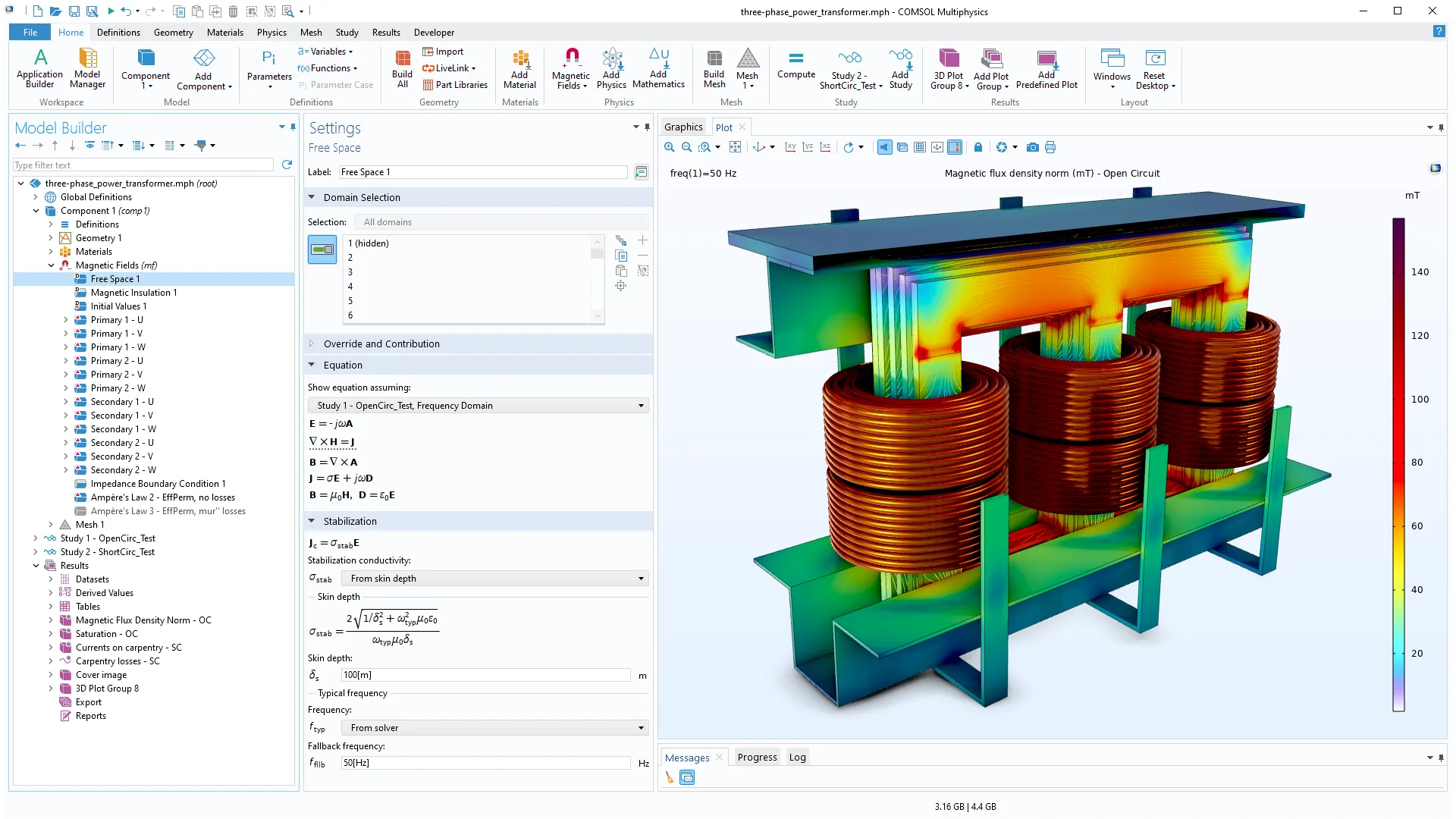问题描述
When creating a new Magnetic Fields model in COMSOL Multiphysics 6.2 or newer and following a modeling workflow I got used to in COMSOL Multiphysics 6.1 or earlier, I get different results. It seems the material properties assigned to some of the domains have not been considered. Why does this happen, and what can I do about it?
解决方法
A new workflow and its logic
A new default feature, Free Space, was added to the Magnetic Fields interface in COMSOL Multiphysics 6.2. It represents the physical conditions in the free space - typically air or vacuum - surrounding the modeled device. The electromagnetic material properties of the free space are defined by the feature, and therefore override any of the properties supplied by the Materials node.
The Free Space feature provides a canvas on top of which other features, such as Ampère’s Law in Fluids, Ampère’s Law in Solids, Magnet, Passive Conductor, Laminated Core, and Coil can be added. One such feature must be applied to any domain where you want to use material properties different from those of free space. Additionally, some of these features allow you to specify an excitation source, such as a current flowing through a Coil.
Most of the example models featuring the Magnetic Fields interface demonstrate this workflow. See for example this one. The next two sections discuss the extra benefit of using the Free Space feature, and the distinction between the Ampère’s Law in Solids and Ampère’s Law in Fluids features.
The Free Space and the Stabilization conductivity
The Free Space feature implements a conductivity governed by the Stabilization Conductivity dropdown menu. In 3D, it defaults to Automatic, which provides a stabilization conductivity for Frequency Domain and Time Dependent simulations. The conductivity is defined such that the skin depth in free space becomes 100 times greater than the diagonal of the bounding box of the geometry. Such a small conductivity is expected to have a negligible impact on the fidelity of the results, but its presence improves the solver's reliability and speed.
User-defined options for manual tuning of the stabilization are available as well. In 2D, the Stabilization Conductivity is off per default, and is rarely needed. More information and detailed specifications can be found in the documentation.
The difference between Ampère’s Law in Solids and Ampère’s Law in Fluids
The new workflow has introduced two types of Ampère’s Law; Ampère’s Law in Solids and Ampère’s Law in Fluids. These determine how materials behave and how material properties are interpreted when when mechanical deformation is involved. This matters if your model has a Moving Mesh and/or Solid Mechanics interface coupled with the magnetic problem.
The Ampère’s Law in Solids feature applies to solid materials whose material properties are affected during deformation and, for instance, depend on the material strain or material orientation. Features such as Magnet, Passive Conductor, and Laminated Core also behave as solids. Meanwhile, the Ampère’s Law in Fluids feature applies to nonsolid materials, whose properties can be considered a independent of the deformations.
More information can be found in the documentation.
Note: In COMSOL Multiphysics 6.1 and earlier, the distinction between solid and fluid materials was controlled within the Ampère’s Law node by specifying Solid/Nonsolid in the Material type setting. In newer versions, the same logic is still kept for the Coil feature.

The Free Space default feature with the Stabilization option, as demonstrated for a model of a three-phase power transformer. Please notice the Ampère’s Law in Solids and several Coil nodes added further down in the Model Tree.
The Free Space feature in some other AC/DC interfaces
A similar workflow has been introduced for the Electrostatics, Magnetic and Electric Fields, and Magnetic Fields, Currents Only interfaces, starting from COMSOL Multiphysics 6.3. The motivation and the logic are the same.
Note: The Free Space feature for the Magnetic and Electric Fields interface comes with a built-in Stabilization conductivity option which is different from the one used for the Magnetic Fields interface. By default, it adds a conductivity of 1 S/m to prevent Stationary and Time Dependent studies from becoming singular. Frequency Domain studies with this interface often do not require any stabilization conductivity.
Backward compatibility
A model saved in an older version and created with the old workflow will be opened in the current COMSOL version's GUI with legacy Ampère's Law nodes retained. You will have the possibility to add the Free Space feature manually if necessary.
Beware that the new workflow may impact backward compatibility with respect to API support. Any model method, Java® code, and MATLAB® code that has been saved using previous COMSOL versions may need to be revised in order to function properly. Please follow our recommendations here.
COMSOL 尽一切合理的努力验证您在此页面上查看的信息。本页面提供的资源和文档仅供参考,COMSOL 对其有效性不作任何明示或暗示的声明。COMSOL 对所披露数据的准确性不承担任何法律责任。本文档中引用的任何商标均为其各自所有者的财产。有关完整的商标详细信息,请参阅产品手册。
